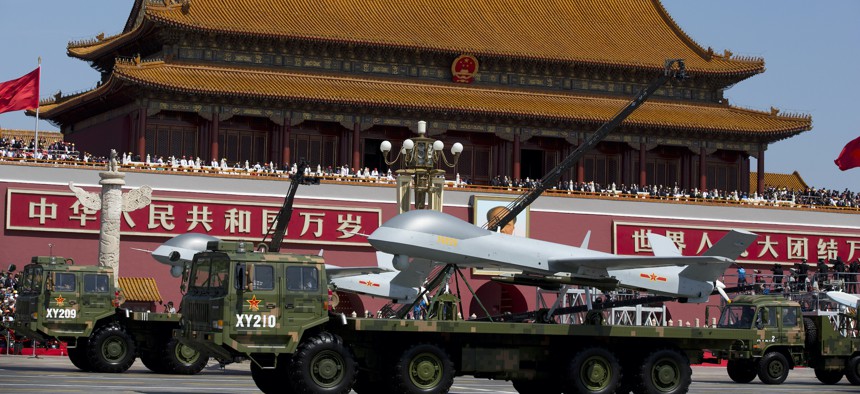
The People’s Liberation Army has yet to adopt a definition, let alone a formal plan, for “intelligentization (智能化),” a Chinese vision for the transformation of warfare through artificial intelligence and automation. But Chinese military theorists see it as a rare opportunity for “leapfrog development” over adversaries. One author suggests that Star Wars will “become a reality”; another says the fantasies from “mythological fiction” will come true. Their writings, while not authoritative, have coalesced around several key themes that offer a crucial glimpse into potential PLA thinking and ambitions.
The PLA internalized lessons on “mechanization” and “platform-centric warfare” from the Second World War, and on “informationization” and networked operations from U.S. operations in the 1991 Gulf War. Whereas these earlier eras of warfare turned on “mechanization” in the “physical space” and “informationization” in the “information space,” PLA theorists argue that intelligentization will center upon a “cognitive space” that privileges complex thinking and effective decision-making. On battlefields where advanced AI technology enables better decisions, they write, the side that can better integrate human creativity and robotic calculating capacity will hold the crucial edge.
Chinese theorists often describe warfare that depends on humans and machines to collaborate as “algorithmic warfare,” an interesting parallel to the phrasing used by Robert Work, former deputy defense secretary. They also write about how “human-machine collaboration” can “realize human self-transcendence” and immeasurably improve the PLA’s centralized decision-making capability. A crucial use of artificial intelligence, they believe, will be in “battlefield perception systems,” a system that translates high-quality targeting data into ideal target sets for operational commanders.
PLA strategists also believe that ever-more-advanced autonomous systems will gradually replace human frontline combatants. These theorists believe the air domain has the highest potential for autonomy, with drones being integrated into air combat in two major ways. The first is unmanned-manned cooperation, wherein manned “mothership” fighters will direct autonomous drones during battle. The second is swarm warfare, which aims to overwhelm the enemy with masses of intelligent drones. The arrival of intelligent drones is expected to accelerate the OODA loop in unimaginable ways and to rewrite the “rules of the game” of air warfare.
Indeed, the military value of these systems will be more than their ability to destroy enemy forces, the strategists write. Above all, intelligentization will aim to achieve advantages in psychological warfare. Theorists describe a “cognitive confrontation,” in which PLA leaders will psychologically dominate opposing commanders through better and faster decisions. The PLA plans to employ all available tools to the overarching objective of reducing an enemy’s will to resist.
The United States military should work to better understand Chinese conceptions of intelligentization and the PLA’s efforts to integrate it into its model of future warfare. Taking advantage of some of the possible weaknesses of the PLA’s approach should be a top priority and would also help the United States military to shore up some of the weaknesses in its own vision and efforts. We recommend several key initiatives.
First, the simultaneous American efforts on joint all domain operations and JADC2 approaches and Chinese intelligentization may result in a future of parity, and despite major investments and progress, neither side will have gained a decisive advantage. However, nuanced differences in operational implementation, especially regarding mission command approaches for highly networked joint forces, may provide the U.S. with a margin of advantage. The U.S. military should move beyond its focus on technologies and system investments, and mature associated C2 and organizational aspects in parallel.
Second, the United States could enhance its own focus more on how attack the vulnerabilities of adversary battle networks and command and control (C2) systems. Intelligentization clearly seeks to build a highly centralized, and consequently potentially vulnerable, decision-making process for the PLA. Closely studying how to take advantage of these systems and approaches not only would give the United States a critical edge in future warfare, it would also help the U.S. military better understand the nature of its own envisioned future battle network and C2 vulnerabilities and more rapidly identify and attempt to mitigate them.
Third, the United States military should be more public in its discussions about the PLA’s intelligentization efforts. With other notable PLA efforts, the United States military has been content with sitting on classified awareness while losing valuable time for mobilizing a response. Several years were lost during the South China Sea island building campaign. Most recently, U.S. Strategic Command’s vague and scant public details about the rapid growth of the Chinese nuclear program did little, only for open-source investigators to finally sufficiently expose the efforts several years later. In the case of intelligentization, the U.S. military should not repeat this mistake yet again. Instead, it should more clearly highlight the nature of the PLA’s efforts as they continue to develop.
Lastly, the U.S. military should ready itself for a future warfighting environment, where the PLA’s realization of its intelligenization ambitions will increase vulnerabilities to the American way of war. If realized, Chinese military strategists’ ambitions could portend an environment that has become less familiar in recent decades for the U.S. military—one in which disorientation, misinformation, and complex deception are commonplace during conflict with a peer adversary. Preparing for this increasing possibility, while maintaining resolve, and effectiveness will be essential to prevailing in a cognitive confrontation.
China believes it is racing toward AI-enabled future military dominance. However, it remains unclear if China is truly on the cusp of achieving a Revolution in Military Affairs, or if it is merely stumbling along with paralleling some of the post-Cold War approaches and ambitions of the U.S. military. Either way, a deeper understanding of the PLA’s push toward intelligentization can galvanize constructive American military efforts and preparedness, regardless of China’s actual progress.
No comments:
Post a Comment